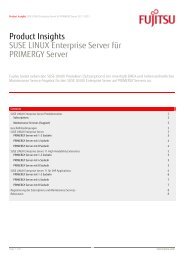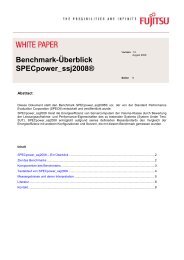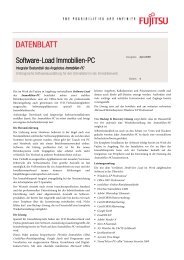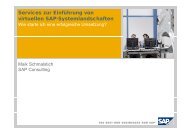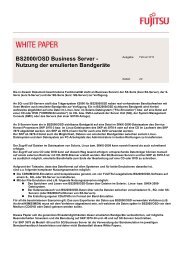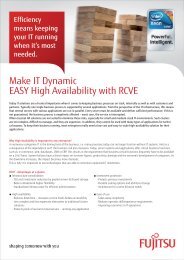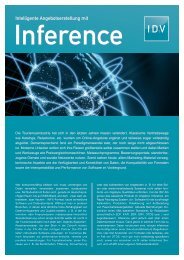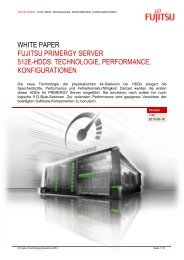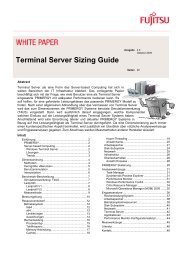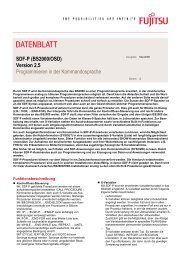Performance report primergy rx300 s7 - fujitsu global
Performance report primergy rx300 s7 - fujitsu global
Performance report primergy rx300 s7 - fujitsu global
You also want an ePaper? Increase the reach of your titles
YUMPU automatically turns print PDFs into web optimized ePapers that Google loves.
WHITE PAPER PERFORMANCE REPORT PRIMERGY RX300 S7 VERSION: 1.3 2012-10-09<br />
SPECpower_ssj2008<br />
Benchmark description<br />
SPECpower_ssj2008 is the first industry-standard SPEC benchmark that evaluates the power and<br />
performance characteristics of a server. With SPECpower_ssj2008 SPEC has defined standards for server<br />
power measurements in the same way they have done for performance.<br />
The benchmark workload represents typical server-side Java business applications. The workload is<br />
scalable, multi-threaded, portable across a wide range of platforms and easy to run. The benchmark tests<br />
CPUs, caches, the memory hierarchy and scalability of symmetric multiprocessor systems (SMPs), as well<br />
as the implementation of Java Virtual Machine (JVM), Just In Time (JIT) compilers, garbage collection,<br />
threads and some aspects of the operating system.<br />
SPECpower_ssj2008 <strong>report</strong>s power consumption for<br />
servers at different performance levels — from 100% to<br />
―active idle‖ in 10% segments — over a set period of<br />
time. The graduated workload recognizes the fact that<br />
processing loads and power consumption on servers<br />
vary substantially over the course of days or weeks. To<br />
compute a power-performance metric across all levels,<br />
measured transaction throughputs for each segment are<br />
added together and then divided by the sum of the<br />
average power consumed for each segment. The result<br />
is a figure of merit called ―overall ssj_ops/watt‖. This<br />
ratio provides information about the energy efficiency of<br />
the measured server. The defined measurement<br />
standard enables customers to compare it with other<br />
configurations and servers measured with<br />
SPECpower_ssj2008. The diagram shows a typical<br />
graph of a SPECpower_ssj2008 result.<br />
The benchmark runs on a wide variety of<br />
operating systems and hardware<br />
architectures and does not require extensive<br />
client or storage infrastructure. The minimum<br />
equipment for SPEC-compliant testing is two<br />
networked computers, plus a power analyzer<br />
and a temperature sensor. One computer is<br />
the System Under Test (SUT) which runs<br />
one of the supported operating systems and<br />
the JVM. The JVM provides the environment<br />
required to run the SPECpower_ssj2008<br />
workload which is implemented in Java. The<br />
other computer is a ―Control & Collection<br />
System‖ (CCS) which controls the operation<br />
of the benchmark and captures the power,<br />
performance and temperature readings for<br />
<strong>report</strong>ing. The diagram provides an overview<br />
of the basic structure of the benchmark<br />
configuration and the various components.<br />
Page 16 (59) © Fujitsu Technology Solutions 2012



